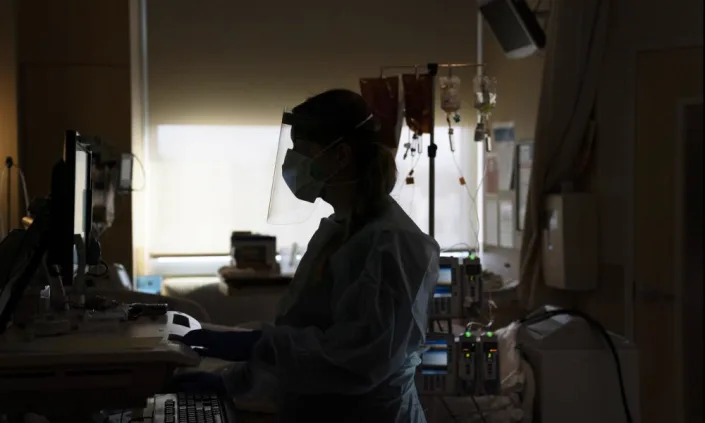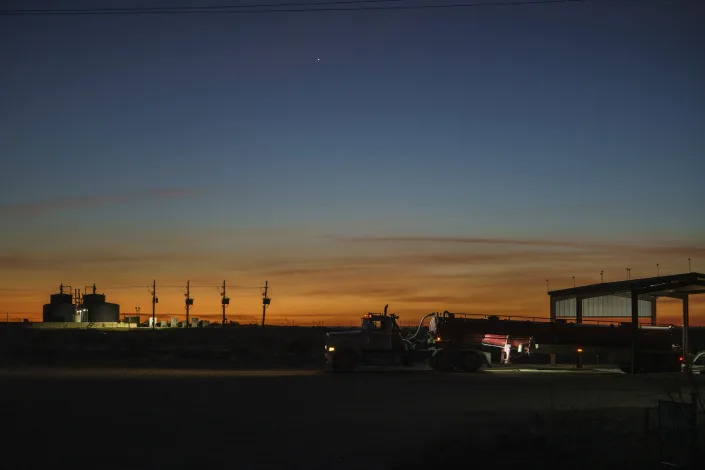Albuquerque Journal, N.M
There’s almost unlimited clean, geothermal energy under our feet. New tech could help unleash that potential in New Mexico.
Kevin Robinson-Avila, Albuquerque Journal, N.M. – January 28, 2023
Jan. 28—Canadian company Eavor Inc. drilled an 18,000-foot well bore this past fall in southwest New Mexico to prove it could hammer its way through deep-underground, hard-granite rock to reach previously untapped geothermal energy.
Eavor’s well now stands as the deepest hole ever drilled in New Mexico, successfully demonstrating that the company’s new technology can potentially crack open access to vast subsurface hot-rock formations that offer massive amounts of clean, renewable energy.
Eavor’s success is just the latest achievement in what could soon become a global renaissance in geothermal development that’s got both industry experts and public officials hyped about the potential for unleashing a virtually unlimited source of clean energy for electric generation, and for heating and cooling of homes and buildings.
“We have massive geothermal resources sitting below our feet, but it’s been elusive to tap into the deep subsurface areas we need to reach to extract that energy economically and use it,” Eavor Vice President of Business Development Neil Ethier told the Journal. “… Our drilling project in southwest New Mexico showed that our technology can unlock that geothermal potential, and it’s now ready for commercial development.”
In fact, the company is preparing to break ground in Nevada on its first 20-megawatt geothermal power plant in the U.S. using its new technology to exploit deep hot-rock formations. The project will supply power to local utility NV Energy, pending approval by state regulators in Nevada.
That project could be the first of many new power plants Eavor expects to build in western states, where geothermal energy is more readily accessible at levels closer to the surface than in other places. Eventually, that could include New Mexico as well, which has the sixth-highest geothermal potential in the nation, according to the National Renewable Energy Laboratory in Colorado.
“New Mexico’s geothermal resource is very good,” Ethier said. “It’s a wonderful opportunity for New Mexico to develop clean, firm, baseload electricity that employs New Mexicans.”
Eavor is one of many companies now aggressively pursuing geothermal development with modern drilling technologies that allow them to tap into the deep underground rock formations that eluded the industry in years past.
Texas-based Fervo Technologies, for example, has also signed new power purchase agreements in western states to build modern geothermal power plants, including three separate projects with utilities in California for a combined total of nearly 100 MW of generation. And, as that company perfects its drilling techniques — and as economies of scale kick in to lower costs — Fervo expects to target a lot more places for geothermal development, including New Mexico, said Fervo Senior Associate for Policy and Regulatory Affairs Laura Singer.
“We definitely see New Mexico as an opportunity for the future once we get our drilling costs lower and our techniques fully hammered out,” Singer told the Journal.
State legislation
Both Eavor and Fervo met with a geothermal working group last year that state Sen. Gerald Ortiz y Pino, D-Albuquerque, formed to explore local development potential, paving the way for newly proposed legislation in this year’s session to promote the industry.
Ortiz y Pino has filed the Geothermal Resources Development Act, Senate Bill 8, to provide $25 million in state money for grants and loans for research and development of geothermal energy projects around New Mexico. And he filed a second bill, SB-173, to offer up to $10 million annually in tax breaks for new geothermal projects.
The legislation could inspire more investment in both geothermal electric generation, and use of geothermal energy to heat and cool homes and buildings.
Heating-and-cooling technology is well developed. But it requires more education and promotional incentives to encourage broad market adoption and deployment.
In contrast, geothermal electric generation based on today’s emerging technologies that target deep hot-rock formations is still evolving. But it’s nearing the commercial break-out point.
“We’re on the cusp of it,” Ortiz y Pino told the Journal. “Eavor just drilled a hole nearly 19,000 feet deep to show it can do this. That opens the door to a lot more potential development as other energy companies jump in.”
Both of Ortiz y Pino’s bills have bipartisan support, with two Republican senators co-sponsoring them. And more bipartisan backing is likely, Ortiz y Pino said.
That’s because, apart from offering clean “baseload” energy that can operate 24/7 all year long, today’s emerging technology could also create direct employment opportunities for workers in the oil and gas industry as the state diversifies away from fossil fuels.
Drilling for heat, not hydrocarbons
Indeed, it’s the modern drilling technologies developed by the oil and gas industry that are opening the gateway to deep underground geothermal energy, making the drilling rigs and skilled workforce that manage today’s oil and gas operations essential for companies like Eavor and Fervo to bust through hard, subsurface granite to reach hot-rock formations.
“We’re piggybacking off technology advancements in oil and gas drilling,” Ethier said. “But instead of drilling for hydrocarbons, we’re drilling for heat. Fifteen years ago we couldn’t do this.”
Modern hydraulic fracturing methods that include hardened drill bits to crack open tough shale beds — plus advanced seismic sensor technology and data analysis to pinpoint and accurately target underground hydrocarbon deposits — all contributed to the shale gas revolution, allowing the industry to exploit previously untapped oil-and-gas reservoirs.
More recently, horizontal drilling technology has pushed oil and gas operations into unprecedented levels of development, permitting operators to penetrate laterally into shale beds stretching in all directions to reach more pockets of hydrocarbons.
Now, those same drilling techniques — combined with further technology development by the geothermal companies themselves — is creating a paradigm shift that, for the first time, lets developers dig far below the shallow hot water aquifers that the geothermal industry has traditionally targeted to instead bore deeper down into hot-rock formations.
That capability opens up access to far more geothermal energy in many more places, because developers are no longer limited to exploring and developing around volcanos and fault lines where natural subsurface fracturing has created pools of relatively shallow, underground reservoirs. Such conditions are relatively rare and are concentrated in certain places, such as the western U.S.
“The industry has been historically limited to conventional wet, steamy reservoirs where developers look for the steam and natural fault lines,” Singer said. “We don’t need steam now. We look instead for hot rock at reasonable depths. Subsurface heat exists everywhere — it’s just a matter of how deep it is.”
Nearly 20 years ago, extensive research showed that intense subsurface heat is ubiquitous and basically inexhaustible nearly everywhere below the Earth’s crust, with heat level depending on depth, said Shari Kelly, a senior geophysicist and field geologist with the state Bureau of Geology and Mineral Resources.
“We came to realize that no matter where you are in the U.S. — even if it’s Connecticut — if you drill deep enough you can reach temperatures that are usable for heat and electricity,” Kelly told the Journal. “… That really shifted the perspective on geothermal development.”
The challenge, however, has been lack of adequate drilling technology that could slice through hard rock to reach the necessary depths while also withstanding extreme subsurface temperatures that can shut down drilling equipment.
“Today’s drilling technology allows developers to reach those deep depths,” Kelly said. “It’s a game changer.”
Advancing the technology
Companies like Fervo and Eavor are now building on oil and gas drilling technology to develop techniques and methods specifically geared toward deep geothermal development.
Fervo, for example, has developed advanced data analytics using down-hole fiber optics to gather and analyze real-time data on flow, temperature and performance of geothermal resources, Singer said. That provides much greater insight into subsurface behavior, allowing the company to precisely identify where the best resources exist and optimize well performance.
Once the hole is drilled and fracked, the company pumps cold water down into the well bore, where it’s heated to between 350 and 400 degrees Fahrenheit and then brought back to the surface to create steam to run a turbine generator.
Conventional wells that tap into existing hot water aquifers usually don’t penetrate below 3,000 feet down, and those wells generally only produce between 200- and 300-degree heat. In contrast, Fervo is targeting rock formations at 8,000-10,000 feet down, providing much greater heat for more efficient and abundant generating capacity.
“Some companies are looking to drill extremely deep into extremely hot rock,” Singer said. “We’re not. We’re targeting more moderate depths that allow us to use existing oil and gas drill bits and equipment.”
Eavor, meanwhile, has created new technology to drill far deeper wells of up to 23,000 feet or more, Ethier said. That requires extreme temperature-resistant equipment with reinforced drill bits to break through hard granite rock.
To do that, it’s created proprietary insulated drill pipes and partnered with industry vendors to design new drill bits. It’s also developed advanced down-well control technology to precisely place liquid-filled pipes through two well bores that pump water down for heating at the geothermal resource and then bring it back up again.
And the entire process is contained in a novel, closed-loop system where the water being heated never leaves the underground or surface pipes. Rather, it absorbs heat from the hot-rock bed like a radiator, using horizontal drilling to place piping offshoots directly next to the geothermal resource, which then heats up the water inside the tubes before it’s brought back to the surface.
“We have over 30 patents covering a lot of technology components, including proprietary software, hardware and system design,” Ethier said.
Eavor directly tested most of its technology in the New Mexico Bootheel at a drill site located next to the Lightning Dock geothermal power plant near Lordsburg. That’s the only conventional geothermal facility currently operating in the state.
“We met all our technology milestones,” Ethier said.
Future employment opportunities
That test operation also demonstrated lucrative future employment potential for oil and gas industry workers. Two conventional drilling rigs were used on the project, which lasted from August to December last year.
“We had more than 50 people employed at the rig site throughout construction,” Ethier said. “And that doesn’t include local services we used for fuel and water delivery, or for sewage and garbage disposal. It was also a boon for local hotels and restaurants in the area.”
As industry development gains momentum and companies begin drilling deeper wells for power plants, and for heating and cooling applications, a lot more employment opportunities could emerge for skilled oil and gas drilling crews, engineers and seasoned industry professionals.
In fact, most companies now pursuing modern geothermal development are largely run by former oil and gas executives and staffed by industry workers. Helmerich & Payne Inc., for example — an oil and gas drilling rig operator — is an investor in Eavor.
Global drilling company Baker Hughes also formed a partnership with two industry giants, Continental Resources and Chesapeake Energy, to test whether they can profitably turn spent natural gas wells into geothermal facilities, according to Politico. And Chevron New Energies, a subsidiary of Chevron Corp., is partnering with Sweden’s Baseload Capital to develop new geothermal technologies, starting with a new project in Weepah Hills mountains in Nevada.
“We’re not taking away from the oil and gas industry, but adding stability to it,” Ethier said. “This can provide a just transition for energy diversification that offers other options for employment.”
Forging ahead
Full-scale deployment of emerging geothermal technology — now called enhanced geothermal systems, or ESG — is still a few years off, but it’s a lot closer that many think, Singer said.
“We’re ready to deploy,” she said. “This is not technology that needs to be reinvented, because the technology and skills are there. It’s a matter of just starting to drill wells, and we’re ready to go.”
As momentum accelerates, it will allow drilling and development costs to decline through economies of scale and continuous technology and system efficiency improvement, making ESG more economical compared with fossil fuels like natural gas, Singer added.
“One reason for the shale gas revolution success was continuous drilling and constantly evolving technology and techniques to bring down costs,” Singer said. “Geothermal has not yet experienced that, and it’s what’s needed.”
Challenges remain. More temperature-resistant drilling technology, for example, is critical as wells go deeper, and a lot more subsurface research is needed to identify the best places for geothermal development.
Permitting issues could also cause problems, slowing development down the same way transmission projects are routinely held up through local, state and federal regulatory requirements that delay planning and construction for years.
But federal- and state-level investment and incentives can help with all those challenges. The U.S. Department of Energy announced in September a new “Energy Earthshot” to lower the costs for ESG by 90% to $45 per megawatt hour by 2035, which would make it significantly more affordable than today’s prices for natural gas.
That includes $44 million in new investment’s in ESG through the DOE’s Frontier Observatory for Geothermal Energy Research laboratory in Utah, plus $84 million in funding under the federal Bipartisan Infrastructure Investment law to support four ESG demonstration projects in different locations.
State-level initiatives like Ortiz y Pino’s bills can also help. And apart from potential bipartisan legislative support, environmental organizations are getting on board, given geothermal’s potential to provide clean backup power for intermittent solar and wind facilities as the state transitions from fossil fuels to renewables.
Some environmental activists took leading roles in Ortiz y Pino’s working group, and environmental organizations are expected to firmly back the senator’s bills in this year’s session.
“It’s such a great opportunity for us to supplement wind and solar in a sustainable fashion,” Ortiz y Pino said. “Geothermal runs 24/7, 365 days a year. It doesn’t go away, and it makes freeing ourselves from fossil fuels much more realistic.”
Sandia National Laboratories’ drilling research, long used by oil and gas firms, is being put to use for clean geothermal energy development
Sandia wants to make those efforts more efficient and less expensive…
In the near future, clean geothermal energy could heat and cool the entire University
The University of New Mexico’s Utility Services Department could in the near future he…










